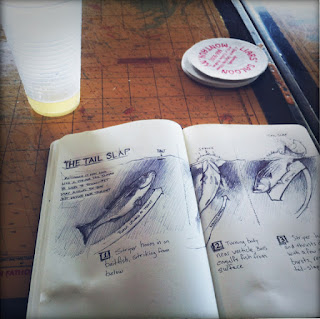 |
| Drinking & Drawing, Liars Saloon Montauk, N.Y. |
I'm not a scientist or a marine biologist, and I didn't stay at a Holiday Inn last night. But I do draw 'em like I see 'em. On a recent visit to Bass Pro Shops I noticed a very interesting clue into this discussion when I saw a live-fish feeding in their huge 35,000 gallon aquarium. The tank had every fresh water game fish imaginable, included a few Cape Cod Canal-transported striped bass.
The crowd got an up close and personal look at these fish massacring dozens of large shiners. Immediately drawn to the stripers, I noticed that after a shiner was taken on the surface, the force and momentum of the fish turning after the strike ended each time with some variation of an accidental tail slap.
I sketched it in my fishing log while drinking a few cold ones at Liars Saloon, between the good tides over the weekend:
1. The striper hones in on a fish, turning upward aiming at the head of the target.
2. Turning body vertical, the fish strikes from below
3. Right after the strike, striper carries momentum through turing 180 degrees, and powers with a few powerful sweeps from the tail back down below.
When the bass made that last move (3), each went below with a tail-slap on the surface, which makes me think if a striper hits your plug and misses, the follow-through may send your lure flying, or result in a tail-hooked fish. The fish knows it didn't eat, so it makes another pass right after, or possibly a competing fish takes the plug instead.
I'm not sure what side of the debate I stand, although this proves to me the slap is unintentional at least some of the time. It would be interesting to hear from a biologist that is in the know. Maybe that's the next illustrated project added to the to-do list.
-M
I sketched it in my fishing log while drinking a few cold ones at Liars Saloon, between the good tides over the weekend:
1. The striper hones in on a fish, turning upward aiming at the head of the target.
2. Turning body vertical, the fish strikes from below
3. Right after the strike, striper carries momentum through turing 180 degrees, and powers with a few powerful sweeps from the tail back down below.
I'm not sure what side of the debate I stand, although this proves to me the slap is unintentional at least some of the time. It would be interesting to hear from a biologist that is in the know. Maybe that's the next illustrated project added to the to-do list.
-M



1 comment:
Thanks Nate. I feel the same, that it would be a waste of energy on the fishes part, as well as them possibly losing their prey to other fish.
I guess it's our job as outdoorsman to over analyze everything
-M
Post a Comment